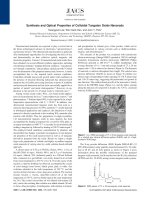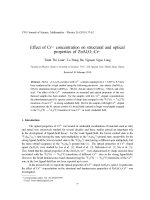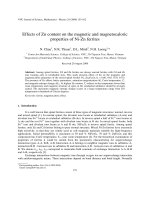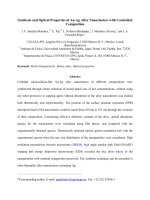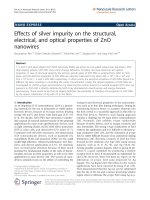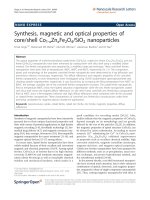DEFECT INDUCED NOVEL ELECTRICAL, MAGNETIC AND OPTICAL PROPERTIES OF TIO2 THIN FILMS GROWN BY PULSED LASER DEPOSITION
Bạn đang xem bản rút gọn của tài liệu. Xem và tải ngay bản đầy đủ của tài liệu tại đây (6.24 MB, 142 trang )
i
DEFECT INDUCED NOVEL ELECTRICAL, MAGNETIC
AND OPTICAL PROPERTIES OF TiO
2
THIN FILMS
GROWN BY PULSED LASER DEPOSITION
TARAPADA SARKAR
(M.Tech., INDIAN INSTITUTE OF TECHNOLOGY, KHARAGPUR)
A THESIS SUBMITTED
FOR THE DEGREE OF DOCTOR OF PHILOSOPHY IN
SCIENCE
DEPARTMENT OF PHYSICS
NATIONAL UNIVERSITY OF SINGAPORE 2015
ii
DECLARATION
I hereby declare that thesis is my original work and it has been written by me in it’s
entirety. I have duly acknowledged all the sources of information which have been
used in the thesis.
This thesis has not also been submitted for any degree in any university previously.
Tarapada Sarkar
15 August 2015
iii
ACKNOWLEDGEMENTS
The completion of my dissertation and subsequent Ph.D. has been a long journey. It
was a journey of 4 yrs and 6 months which taught me a lesson that life doesn’t stand
still, nor wait until you are finished. Many things have happened and changed in the
time in which I have been involved with this project. Many have questioned whether I
would finish my dissertation, and have doubted my commitment to it. I, on the other
hand, losing confidence so many times that I could not keep count of, jumping here and
there, computers crashing, needing to work as much as possible, so many sleepless
night and pure frustration had to push on. With all this, I knew that I will complete my
Ph.D. I just had to do it in my own time and on my own terms.
I am grateful to a lot of people who have been instrumental in enabling me to reach
my goal. It humbles me to acknowledge them. If I have to name one man for whom I
am writing this thesis and this acknowledgement, he has to be my supervisor, Prof. T.
Venkatesan. Venky, as he is called by one and all has been one of the biggest influences
in my life. I consider myself to be extremely fortunate to have known, worked together
with and been supervised by Venky. He has encouraged me in all my efforts and
endeavours. He has managed to keep me motivated in my research. Venky has been
extremely patient with me. Venky has had a tremendous contribution in my
development as an individual.
I also want to take this opportunity to acknowledge my co-supervisor, Prof. Ariando.
Prof. Ariando has been extremely supportive and had taken keen interest in my research
activities. Thanks to Prof J.M.D Coey for the invaluable feedback and inputs in my
research work. I thank to Dr. Sankar Dhar and Dr. Arkajit Roy Barman, my mentors,
who helped me a lot in my 1
st
two years of Ph.D. They have been of extraordinary help
iv
in helping me manage my research work and giving direction to it. Their critical inputs
have definitely helped me in taking my work to the next level. I thank Prof. A. Rusydi
for his help in understanding the use of optical and x-ray spectroscopy for looking at
defects in TiO
2
. They have been of tremendous help with experiments as well as
theoretical understandings of my subject. I also thank Prof. H. Yang for the many
fruitful discussions and the opportunities to work together.
I want to thank Dr. K. Gopinadhan. Gopi has been the epitome of sincerity whom all
graduate students in our lab have tried to idolize. Gopi has helped me a lot with transport
measurements and helped me understand the intricate physics related. I would also want
to thank Dr. S. Saha. We have been good friends in the few days that we have known
each other. He has helped me with Raman measurements and with understanding of the
data. I thank Dr. C.B. Tay- Chuan Beng is a very helpful individual and is always ready
to help with PL measurements. I must thank Dr. W. Lú- Weiming has helped me a lot
with SQUID measurements and also with PLD depositions. I have been fortunate
enough to have some of the most wonderful, talented and helpful lab-mates. I want to
thank Mallikarjuna rao Motapothula, Anil Annadi, Liu Zhiqi, Yong Liang Zhao, Teguh
Citra Asmara, Zhihua Yong, Amar Srivastava, Siddhartha Ghosh, Naomi Nandakumar,
Abhijeet Patra, Soumya Sarkar, Zeng Shengwei, Ma Haijiao, Abhimunya Rana, Brijesh
Kumar, Meenakshi Annamalai, Xiao Wang, Michal Dykas, Masoumeh Fazlali Pranjol
kumar Gogoi, and Marlini.
It is difficult to express love and gratitude to family members. I would like to thank my
family, my parents who raised me with a love of science and supported me in all my
pursuits. I love you and will forever be indebted to you for giving me life, and
unconditional love that will carry me through hard times.
v
TABLE OF CONTENTS
DECLARATION ii
ACKNOWLEDGEMENTS iii
TABLE OF CONTENTS v
ABSTRACT vii
LIST OF PUBLICATION ix
LIST OF FIGURES xi
LIST OF SYMBOLS xiv
Chapter-1 Introduction 1
1. 2 Crystal Structure of TiO
2
1
1. 3 Physical Properties of TiO
2
4
1. 4 Electronic Band Structure of TiO
2
5
1. 5 Defects and Substituting at Ti site in TiO
2
6
1.5. 1 Oxygen vacancy 6
1.5. 2 Titanium vacancy 8
1.5. 3 Substituting for Ti in TiO2 9
1. 6 Applications of TiO
2
10
1.6. 1 Photoactivity of TiO
2
11
Chapter-2 Growth and Characterization Technique 13
2. 1 Pulsed Laser Deposition Technique 14
2. 2 X-Ray Diffraction (XRD) 16
2. 3 Rutherford backscattering-Ion Channelling 18
2. 4 Magnetic Property Measurement System (MPMS) 20
2. 5 Physical Property Measurement System 23
2. 6 Raman spectroscopy 25
2. 7 Scanning Tunneling Microscopy 29
2. 8 Atomic Force microscopy 31
Chapter-3 Kondo effect and ferromagnetism 33
3. 1 Brief history of Kondo effect 34
3. 2 Experimental Methods 38
3. 3 Magnetic and electrical transport of Ta
0.06
Ti
0.94
O
2
39
vi
3. 4 Thermopower and magnetic susceptibility Measurement 53
3. 5 Conclusion 57
Chapter-4 Evidence formid-gap states and polarons in anatase
Ta
x
Ti
1-x
O
2
surface 58
4. 1 Introduction 59
4. 2 Experimental 60
4. 3 Results and Discussion 60
4. 4 Conclusion 71
Chapter-5 Electron transport at the TiO
2
surfaces of rutile, anatase
and strontium titanates: the influence of corrugation. 72
5. 1 A brief history of two dimensional electron gas in oxides. 73
5. 2 Experimental Methods 77
5. 3 Experimental results 78
5. 4 Strontium titanate 81
5. 5 Anatase. 83
5. 6 Rutile 88
5. 7 Discussion 88
5. 8 Conclusion. 93
Chapter-6 Magneli phases 95
6. 1 Experimental method 96
6. 2 Results 97
6. 3 Dicussion 102
6. 4 Conclusion 103
Chapter-7 Summary and Future work 104
7. 1 Simultaneous observation of Kondo effect and magnetism 105
7.2 Electron transport at the TiO
2
surfaces of rutile, anatase and strontium titanates 106
7.3 Evidences of surface mid-gap states and polarons in anatase Ta
x
Ti
1-x
O
2
107
7.4 Future Work 108
vii
ABSTRACT
For over half a century, rutile TiO
2
has been intensively studied by experimentalist and
theoretical scientists due to its interesting physical properties, such as high static
dielectric constant and large uniaxial refractive index. However, over the last few
decades, anatase TiO
2
has become the heart of research due to its better electrical
properties which make it more suitable over rutile phase for solar photovoltaic, photo
catalytic, transparent conductor (TCO), dilute magnetic semiconductor applications.
The objective of this thesis is to investigate the defect induced electrical, optical,
magnetic and structural properties of titanium dioxide (TiO
2
) thin films grown by
pulsed laser deposition (PLD) technique.
Single crystal TiO
2
and tantalum (Ta) doped TiO
2
(Ti
1-x
Ta
x
O
2
) thin films of different
thicknesses were grown epitaxially on lattice matched substrates such as LaAlO
3
and
SrTiO
3
. X-ray diffraction (XRD) studies showed very high quality anatase TiO
2
thin
films. Rutherford backscattering-Ion Channelling (RBS) spectroscopy was used to
study the crystallinity and defect density of all the films deposited. RBS-Ion
Channelling studies showed that the defects which arise due to strain in the film at the
interface reduced with increasing thickness. Ultra Violet-Visible (UV-Vis)
Spectroscopy was used to investigate the band gap of the films. Recently cationic
vacancies in metal oxide has been predicted to form magnetic centers
1
. Ta substitution
in TiO
2
results in donor electrons which are believed to enhance the formation of
compensating cationic defects such as titanium vacancies (V
Ti
) , Ti
3+
and suppress the
formation of anionic vacancies such as oxygen vacancies (V
O
) in a crystal. It is inferred
that Ti vacancy plays an important role in the observation of ferromagnetism and Kondo
scattering in anatase Ti
0.94
Ta
0.06
O
2
thin films with various thicknesses (5-200 nm)
grown on SrTiO
3
(100) substrate. We see ferromagnetism and Kondo scattering
viii
simultaneously in the same system and by studying the distribution of the defects,
magnetism and transport in the films as a function of thickness, we are able to reconcile
the observation.
The systematic variation in the density of states (DOS) of anatase Ta
x
Ti
1-x
O
2
near Fermi
level is investigated using temperature dependent scanning tunnelling spectroscopy. A
mid-gap narrow band is seen at ~ 0.6 eV below the Fermi level in undoped TiO
2
at low
temperature. Spatial electronic inhomogeneity is seen at higher temperatures which is
significantly reduced with Ta substitution. A “gap” in the metallic state of Ta
substituted TiO
2
is seen in similar strongly correlated metals. The mid gap energy is
found to be a linear function of chemical potential with temperature. The measured
value of electron/hole effective mass ratio of undoped TiO
2
~ 0.7, exponentially
increases with increase in Ta doping concentration
.
We propose that such large
enhancement of effective mass in Ta substituted TiO
2
as a strong signature of large
polarons at the surface of anatase TiO
2
.
The two-dimensional electron gas in SrTiO
3
created by an overlayer of amorphous
LaAlO
3
is compared with those at TiO
2
-terminated surfaces of rutile and anatase.
Differences in conductivity are explained in terms of the limiting Ti-O-Ti bond angles
(orbital corrugation), band dispersion and polaron formation. At 300 K, the sheet
conductivity and mobility for anatase exceed those for SrTiO
3
or rutile by one or two
orders of magnitude, respectively. The electrons in rutile become localized below 25K.
ix
LIST OF PUBLICATION
1) Unexpected observation of simultaneous Kondo scattering and ferromagnetism in
Ta alloyed anataseTiO
2
thin films as a function of thickness. Tarapada Sarkar,
K. Gopinadhan, M. Motapothula, S. Saha, Z. Huang, S. Dhar, A. Patra, W. M. Lu,
F. Telesio, I. Pallecchi, Ariando, D. Marré, T. Venkatesan (Scientific Report
,5,13011 (2015))
2) Electron transport at the TiO
2
surfaces of rutile, anatase and strontium titanates: the
influence of orbital corrugation, Tarapada Sarkar, Kalon Gopinadhan, Zhou Jun1,
Surajit Saha, J. M. D. Coey, Yuan Ping Feng, A. Ariando, T. Venkatesan (ACS
Nano (under review))
3) Evidences of surface mid-gap states and polarons in anatase Ta
x
Ti
1-x
O
2,
(Abhimanyu Rana, Tarapada Sarkar, Surajit Saha, Xu Hai, Kalon Gopinadhan,
Amar Srivastava, A. Ariando, Loh Kian Ping, T. Venkatesan Advanced materials
(submitted))
4) Effect of Oxygen Vacancy on Water Contact Angle in 3D and 4F Element Based
Oxides,Tarapada Sarkar, Siddhartha Ghosh, Abhijeet Patra, Meenakshi
Annamalai, Saurav Prakash, Mallikarjuna rao Motapothula, T. Venkatesan.
(Under preparation for energy and environmental science)
5) Anisotropic Magneto Resistance and Planar Hall Effect at the LAO/STO
Heterointerfaces: Effect of Carrier Confinement on Magnetic Interaction. Annadi,
A., Huang, Z., Gopinadhan, K., Wang, X., Srivastava, A., Liu, Z. Q., Ma, H.,
Sarkar, T., Venkatesan, T., Ariando Phys. Rev. B (2013)
x
6) Magnetic-Field Sensitive Quasi-Particle Transitions in a Class of Polar Oxides: A
Raman Spectroscopic Study, Surajit Saha, Bing-Chen Cao, Soumya Sarkar, Chunxiao
Cong, Mallikarjuna rao Motapothula, Saurav Prakash, Tarapada Sarkar,
Siddhartha Ghosh, Amar Srivastava, Anil Annadi Weiming Lu, A. Ariando, Ting
Yu, T. Venkatesan. (Under preparation for Physical review letters)
7) A conducting absorbing Magneli phase , Tarapada Sarkar, et. al., (Under
preparation for Applied physics letters)
xi
LIST OF FIGURES
Figure 1. 1 Crystal structure of (a) Rutile, (b) Anatase 2
Figure 1. 2: Band structure and the corresponding DOS of (a) rutile, (b) anatase, (c)
brookite, and (d) columbite calculated by DFT-GGA. Yellow points indicate the values
obtained with the GW method. The valence band maximum from the DFT-GGA
calculation is set to 0 eV (Reprinted with the permission from American chemical
society) 5
Figure 1. 3: Schematic picture of defects 7
Figure 1.4: A proposed band structure model for anatase TiO2 with oxygen vacancies
8
Figure 1.5: Schematic illustration of aliovalent-doped SrTiO3: doping of the trivalent
cation (a) and pentavalent cation (b) (Reprinted with permission from the American
Chemical Society) 10
Figure 1. 6 : Reaction at a semiconducting photocatalyst interface 12
Figure 2. 1 : Schematic diagram of a pulsed laser deposition chamber. 15
Figure 2. 2 : Schematic diagram of the XRD diffraction 17
Figure 2. 3 RBS spectrum in random (unaligned) mode. 20
Figure 2. 4 : RBS ion channeling mode for a perfect crystalline lattice 20
Figure 2. 5 : Schematic of SQUID system 22
Figure 2. 6 : Schematic diagram of superconducting pick-up coil with 4 windings. 22
Figure 2. 7: Schematic diagram of Josephson junction 23
Figure 2. 8: linear probe schematic : V+/ V- and I+/ I- are connected to the voltage
and current contacts, respectively 24
Figure 2. 9: The Hall bar schematics: V+/ V- and I+/ I- are connected to the voltage
and current contacts, respectively 25
Figure 2. 10: molecular Energy-level diagram showing the states involved in Raman
scattering 27
Figure 2. 11: Schematic diagram of Raman spectrometer. 29
Figure 2. 12: Schematic diagram of STM instrument showing the most common way of
measuring tunneling current. 30
Figure 2. 13: Schematic diagram of AFM instrument showing the most common way of
measuring AFM cantilever deflection 32
Figure 3. 1: Resistance as a function temperature for superconductor normal metal and
kondo effect. 34
Figure 3. 2: The above figure shows the typical in-plane M-H hysteresis loop of Ta:TiO
2
(black line) and Pure TiO
2
(blue line) grown at the same condition at 300 K 40
xii
Figure 3. 3: M vs. H loop of Ta:TiO
2
at room temperature as a function of thickness
41
Figure 3. 4: magnetization and Tantalum channelling minimum yield as a function of
thickness. 41
Figure 3. 5 (a) Resistivity as a function of temperature (scatter line) and fitting (solid
line). Inset shows the carrier density as a function of temperature (b) Resistivity as a
function of temperature (scatter line) and fitting (solid line). Inset shows the resistance
as a function of temperature in the mK range. 43
Figure 3. 6 shows magnetization (red asterisk) and Kondo temperature (blue asterisk)
as a function of thickness. 45
Figure 3. 7: shows measured carried density (red asterisk), compensated carrier (black
asterisk) and magnetization (blue asterisk) as a function of thickness. 46
Figure 3. 8: Tantalum channelling minimum yield as a function of thickness with the
depth varying from the interface to the surface. 48
Figure 3. 9: Lattice d-spacing as a function of thickness. Inset shows the Anatase (004)
peak shift with thickness 49
Figure 3. 10: PL spectra at 20K for anatase Ti1-xTaxO2 thin films (0 ≤ x ≤ 0.08) and
LAO substrate at low energy range (1.8 eV to 3.0 eV). (adopted from A.R. barman’s
thesis ‘DEFECT MEDIATED NOVEL STRUCTURAL, OPTICAL, ELECTRICAL AND
MAGNETIC PROPERTIES IN Ti1-xTaxO2 THIN FILMS’,NUS) 50
Figure 3. 11:In-plane magnetoresistance as a function of thickness. 52
Figure 3. 12: In-plane magnetoresistance for 200 nm film along with theoretical
quadratic (red solid line) and liner fit (blue solid line). Inset shows the in-plane and out
of plane magnetoresistance 53
Figure 3. 13: Thermo power as a function of temperature along with a theoretical fit.
54
Figure 3. 14: shows magnetic susceptibility as a function of temperature 56
Figure 4. 1 a) I-V curve and concurrently acquired dI/dV using lock-in amplified,
spatially averaged of 1000 curves in 100 nm2 area. Inset: The same I-V curve is
expanded by plotting at lower current scale and dI/dV curve on logarithmic scale. (b)
Two spatially averaged I-V curves (black and red) acquitted at temperatures 78 K and
300 K respectively. The extracted value of zero bias conductance by fitting the linear
region (at very low current scale) is indicated on respective curve. (c) Two spatially
averaged I-V curves (black and red) acquired at temperatures 78 K and 300 K
respectively. Inset: The same dI/dV curves expanded by plotting at logarithmic scale.
(d) The panel showing continuous imaging of tunneling spectroscopy current map for
different Ta concentration (2 %, 4 %, 6 %, 8 % showing from left to right) for different
bias voltage (-Ve sample bias as top panel, +Ve sample bias as bottom panel) 63
Figure 4. 2 I-V characteristic and dI/dV curves at different location at low temperature.
64
Figure 4. 3 I -V characteristic and dI/dV curves at different location at low temperature
64
xiii
Figure 4. 4: Raman spectrum of anatase TiO2 with Ta incorporation and (a) frequency
shift with Ta Concentration for mode B1g (b) A1g/ B1g (c) Eg 66
Figure 4. 5: Raman spectrum of anatase TiO2 with Ta incorporation and the
theoretical fitting 67
Figure 4. 6 (a) Spatially averaged (of 1000 curves in 100 nm2 area) dI/dV curve at
temperature 78 K for different Ta concentration. (b) The variation of zero bias
conductance with temperature. (c) The variation of gap with temperature. (d) The
variation in V+ and V- (the values where the tunneling current just start to depart from
linear behavior) and their corresponding mid-gap energy [(V+ + V-)/2] with
temperature. 68
Figure 4. 7 (a) The variation of zero bias conductance with Ta concentration. (b) The
variation of gap with Ta concentration. (c) The variation mid-gap energy [(V+ + V-)/2]
with Ta concentration. (d) The variation of deduced value of electron/hole effective
mass ratio with Ta concentration. 70
Figure 6. 1: (a,b,c) TEM cross sectional images of the film 98
Figure 6. 2: the EELS spectrum of the two different matrix in the TiO2 film 99
Figure 6. 3: Resistivity (orange) and carrier density (blue) as a function temperature 100
Figure 6. 4: (a) absorbance as a function of wave length (b) (αhυ)1/2 vs energy 100
Figure 6. 5: (a) the topography image (b) conductance image 101
Figure 6. 6 : I-V characteristic and dI/dV curves at different location at low temperature of
anatase TiO2 101
Figure 6. 7: I-V characteristic and dI/dV curves at different location at low temperature of
Magneli phase. 102
xiv
LIST OF SYMBOLS
R Resistance µ Mobility
R
s
Sheet resistance B Magnetic field
E Electronic charge n Carrier density
K Kelvin t Time
I Current ρ Resistivity
T Temperature M Magnetic moment
PLD Pulsed laser deposition TCO Transparent conducting oxide
DMS Dilute magnetic semiconductors RBS Rutherford backscattering
XRD X-ray diffraction PL Photoluminescence
AFM Atomic force microscopy FM Ferromagnetism
RT Room temperature ITO Indium Tin Oxide
CVD Chemical vapour deposition UV-Vis Ultra violet- visible
DOS Density of states ALD Atomic layer deposition
APT Atomic probe tomography WL W localization
AHE Anomalous hall effect MR Magnetoresistance
AA Altshuler-Aronov VBM Valence band maximum
CBM Conduction band minimum LAO Lanthanum aluminium oxide
STO Strontium titanium oxide FWHM Full width half maximum
GMR Giant magnetic resonance MTJ Magnetic tunnel junction
HF Hartree-Fock FET Field effect transistor
LDA Local density functional approximation
GGA Generalized gradient approximation
SQUID Superconducting quantum interference device
SIMS Secondary ion mass spectrometry
PPMS Physical properties measurement system
XPS X-ray photoelectron spectroscopy
MRAM Magnetic random access memory
RKKY Ruderman-Kittel-Kasuya-Yosida
BGN Band gap narrowing
xv
1
Chapter-1
1. 1 Introduction
Transition metal oxides are one of the most important class of material systems with
multiple-properties and important technological applicationss. Strong correlation has
made these oxides very interesting in terms of novel Physics phenomena such as metal–
insulator transition, magnetism, superconductivity and many other interesting
manifestations. Oxides can be used as insulators to conductors
2
, transparent conductors,
semiconductors
3
and superconductors
4
. They find many applications such as in CMOS
device,
5
memristors,
6-8
optoelectronic devices,
9
solar panels,
10
detectors,
11
fuel cells,
12
catalysts
13
and so on. Among the transition metal oxides, recent studies in titanium
dioxide (TiO
2
) show that they are potentially useful in the field of magnetism,
14
optoelectronics, solar cell
15
and in photo-catalysis
16
for solar hydrogen generation
17,18
.
The present thesis deals with the fundamental electronic and magnetic properties of
epitaxially grown transition metal doped TiO
2
thin films by pulsed laser deposition
technique on different metal oxide substrates.
1. 2 Crystal Structure of TiO
2
TiO
2
is a wide band gap semiconductor with many structural polymorphs: rutile,
anatase, brookite, TiO
2
(B)
19
, TiO
2
(R)
20
, TiO
2
(H)
21
and Cubic
22
. Among these
polymorphs rutile, anatase and brookite are well known structures. Rutile is the most
stable structure in the bulk form and has been well studied compared to all other
structures. However, anatase and brookite are metastable which could be converted to
rutile form in atmospheric pressure and at high temperature (600-700 °C). The rutile
structure is the simplest form among the three most common structures (rutile, anatase
2
and brookite) as shown in Fig. 1.1(a). It is characterized by the tetragonal space group
P42 /nm. The unit cell of rutile TiO
2
contains two TiO
2
units with Ti at (0,0,0), (1/2,
1/2, 1/2), and O at ± (v,v,0), ± (v+1/2 , 1/2-v, 1/2). The lattice parameters are:
a=b=4.587 Å, c=2.954 Å, and v=0.305 Å .
Figure 1. 1 Crystal structure of (a) Rutile, (b) Anatase
3
Each Ti ion is coordinated octahedrally to six O ions and this TiO
6
octahedron is
distorted. The four equatorial O ions are in the plane of (110). The equatorial Ti-O bond
length is ~1.95 Å and the apical Ti-O bond length is ~1.98 Å. The oxygen octahedra
form chains which share edges along [001] direction and share vertices in the (001)
plane.
The anatase structure of TiO
2
, is shown in Fig. 1.1b, which belongs to the tetragonal
space group I4/amd
23
with the unit cell containing two TiO
2
units. The Ti ions are at
(0, 0, 0) and (0, 1/2, 1/4) and the O ions are at (0, 0, v), (0, 0,-v), (0, 1/2, v+1/4) and (0,
1/2, 1/2-v). The lattice parameters are a=b=3.782 Å, c = 9.502 Å, and v = 0.208 Å
24
.
Like the Rutile structure, each Ti ion is octahedrally coordinated to six O ions, which
is distorted where short Ti-O bond length is ~1.93 Å and long bond length of ~ 1.98 Å
forming zig-zag chains along the [100] and [010] directions.
The brookite phase of TiO
2
is very unstable and has a complex structure. Brookite
structure is characterized by the orthorhombic space group Pbca. The Ti ion is
coordinated octahedrally to six O ions. In this case the Ti-O bond length in the
octahedron is different from each other and ranges from 1.87 to 2.04 Å and the O-Ti-O
bond angle ranges from 77° to 105°.
Anatase TiO
2
has been of more interest to the research community in recent times due
to its high conducting properties where it has been shown to be metallic in nature by
doping 5+ valence transition metal like Ta and Nb. Recently discovered water splitting
ability of TiO
2
has generated a great deal of interest in the field of energy and
environment science research because of its unique conduction band edge which
overlaps the water dissociation energy. More recently Kondo effect
25
and
ferromagnetism
26
has also been observed in the anatase phase of Ta substituted TiO
2
;
making it a more interesting system for studying defect mediated magnetic phenomena.
4
1. 3 Physical Properties of TiO
2
Bulk properties Of TiO
2
27
Atomic radius (Å)
O 0.66 (Covalent bond)
Ti 1.46 (metallic bond)
Ionic radius (Å)
O
-2
1.26
Ti
+4
0.74
Crystal Structure System Space group Lattice Constant (Å)
a b c
Rutile Tetragonal
− 4
/ 4.58 - 2.956
Anatase Tetragonal
− 4
/ 3.74 - 9.56
Brookite Rhombohedral
− 5.44 9.17 5.14
Rutile Anatase Brookite
Density(gm/cc) 4.2743
3.895
4.123
Heat capacity
(J/mol ºC)
55.06 55.56 na
Thermal expansion
Coefficient (ºC
-1
)
8.86x10
-
6
(RT)
Electron mobility
(cm2/V.s)
1
10
na
Band gap
3.00
(Direct)
3.21
(indirect)
3.13
Dielectric constant 80 (RT) 30(RT) na
5
1. 4 Electronic Band Structure of TiO
2
The electronic band structures of the three polymorphous TiO
2
-rutile, anatase and
brookite are shown in figure 1.2. The DFT-GGA band structure of rutile indicates that
it has a direct band gap of 1.85 eV at the Γ point. However, with GW correction, rutile
shows an indirect band gap of 3.23 eV with the VBM at Γ and the conduction band
minimum (CBM) at R.
Whereas, the direct band gap of rutile TiO
2
with GW method shows 3.30 eV which
matches with experimental result of 3.30 eV by PES and IPES
28
. DFT-GGA calculation
shows that anatase has an indirect band gap with the VBM at Δ (0, 0, 0.44) between Γ
and X (0, 0, 0.5) and the CBM at Γ (Figure 1.2(b)). The indirect band gap from is shown
3.62 eV by GW. The Brookite structure has a direct band gap at Γ (Figure 1.2(c)). The
predicted direct band gap with GW is 3.86 eV which is larger than that of anatase (3.57
eV) and rutile (3.30 eV).
Figure 1. 2: Band structure and the corresponding DOS of (a) rutile, (b) anatase, (c)
brookite, and (d) columbite calculated by DFT-GGA. Yellow points indicate the values
obtained with the GW method. The valence band maximum from the DFT-GGA
calculation is set to 0 eV (Reprinted with the permission from American chemical
society)
6
An analysis of the density of states (DOS) for all three major phases depicted in Fig.1.2,
shows predominantly O
2p
-like valence band states and Ti
3d
-like conduction band states
around the band edges. In the octahedral-type crystal field, the five unoccupied d-states
of the central Ti ion are split into the two fold-degenerate e
g
-like states with
and
character and three fold-degenerate t
2g
-like d
xy
, d
yz
and d
xz
type states
29
. The energy
of t
2g
state is lower than e
g
. A weak two-peak separation is visible for rutile, which is
much less prominent for anatase and brookite in the O
2p
-like valence band. The sp
2
hybridization in the planar (Y-shaped) OTi
3
building blocks split O
2p
band in rutile. The
p
x
and p
y
states of the O ion form σ hybrid states with the central Ti ion, which form
the lower edge of the O
2p
-like valence band and extend almost through the whole band.
Whereas, the uppermost valence band edge consists of p
z
-type states that form the lone
pair (out-of-plane) π states which are higher in energy than the sp
2
-like hybrid states.
However, the anatase phase shows slightly different characteristics than rutile and this
arises mainly due to the more T-like shape of the OTi
3
building blocks which lead to
stronger deviations from the ideal sp
2
hybrid states. Brookite shows both rutile-like (Y-
shape) and anatase-like (T-shape) OTi
3
building blocks.
1. 5 Defects and Substituting at Ti site in TiO
2
1.5. 1 Oxygen vacancy
Any material (semiconductor, insulator or metal) contain intrinsic defects which arise
during various growth and fabrication processes. There are many possibilities of such
intrinsic defects. As for example, a semiconductor can have different types of defects
7
such as point, area, line and cluster type. Point defects are vacancy, interstitial or host
impurity (foreign element) (Fig. 1.3) Other most common defects are dislocations, grain
boundaries, twins and stacking faults.
Figure 1. 3: Schematic picture of defects
In a vacancy, as the name suggests, an atom is missing from its site in the crystal lattice.
Most common vacancy in metal oxide like TiO
2
is oxygen vacancy, which arises on
samples sputtered and annealed in UHV, and has been widely studied theoretically as
well as experimentally. These defects are very important for surface properties and bulk
properties. The bulk single crystal has been studied extensively with oxygen vacancy
which are created by UHV annealing
30
, ionic gate
31
and doping with transition metal
32
.
An oxygen vacancy, in a metal oxide like TiO
2,
STO
33
is known to create both a mid-
gap state about 1eV below the bottom of the conduction band and a shallow donor level
much closer to the bottom of the conduction band, which makes the system either an
n-type semiconductor or a metal depending on the carrier concentration.
8
Figure 1.4: A proposed band structure model for anatase TiO2 with oxygen vacancies
Interestingly, room temperature ferromagnetism has been reported in a wide range of
undoped oxides such as TiO
2
34,35
, HfO
2
36
, In
2
O
3
34
, SnO
2
37
and ZnO
38
due to oxygen
vacancy. However, the origin of the room temperature ferromagnetism in all above
oxides still remains controversial.
1.5. 2 Titanium vacancy
Titanium vacancy is a cationic vacancy which is not very common in oxides. However,
Osorio-Guillén et al.
39
pointed out
first that the cationic vacancies are readily formed in
most of the wide band gap oxides due to either hole or electron doping. Later
ferromagnetism via cationic vacancy (with concomitant half-metallicity) in wide band-
gap semiconducting oxides was originally proposed in the theoretical works by Elfimov
et al.
40
. It was predicted that the wide band-gap CaO can become a half-metallic
ferromagnet with about 5% cationic i.e. Ca vacancies which exceed the equilibrium
concentration of vacancies in solid by three orders of magnitude as suggested by
Zunger
39
. However, the realization of such a large amount of cationic vacancies in CaO
has never been achieved. The first experimental observation of a local magnetic
9
moment arising from cationic vacancy was reported by Zhang
25
. They observed
signatures of Kondo effect below 100 K in 5% Nb doped anatase TiO
2
thin films grown
under 10
-4
Torr oxygen partial pressure by pulsed laser deposition (PLD). Using XAS
(X-ray absorption spectroscopy) and XPS (X-ray photoelectron spectroscopy),
supported by first-principle calculations, they showed that the presence of Kondo
scattering in the film was due to localized magnetic moments associated with cationic
(Ti) vacancies produced due to Nb incorporation. However, they did not observe any
ferromagnetism. Later, room temperature ferromagnetism, in Ta doped TiO
2
system
(measured by both magnetization and XMCD) was reported by Andrivo et al.
41
, which
was attributed to the Ti vacancy created due to the Ta incorporation in TiO
2
.
1.5. 3 Substituting for Ti in TiO
2
The substituting of metal or non-metal ions in TiO
2
is a very popular approach to
modify the band structure, surface properties and electronic properties. For the
application in solar cell, many dopants have to be incorporated in to the TiO
2
to reduce
the band gap. TiO
2
has a band gap of >3.0 eV which does not absorb the visible light.
The effective narrowing of the TiO
2
semiconductor bandgap to induce visible light
absorption would not only improve the solar to electrical energy conversion efficiency
of dye sensitized solar cells but would also eventually lead to a titanium dioxide based
solar cell technology which does not need less stable, expensive dye sensitizers for
visible light absorption. However, the doping of metal or non-metal ions in the lattice
of TiO
2
is often accompanied by formation of oxygen vacancies. Several groups have
observed formation of oxygen vacancies in the TiO
2
lattice due to incorporation of
10
cations with valence lower than that of the parent cation (Ti)
32
. In contrast, the higher
valence cation stabilizes the Ti
3+
as well as forms cationic vacancy
41
without producing
oxygen vacancies, as displayed in the Fig. 1.5
Figure 1.5: Schematic illustration of aliovalent-doped SrTiO3: doping of the trivalent
cation (a) and pentavalent cation (b) (Reprinted with permission from the American
Chemical Society)
1. 6 Applications of TiO
2
Titanium dioxide is an extremely important metal oxide. TiO
2
finds diverse applications
in semiconductor, as a transparent conductor (TCO), photocatalyst in energy
conversion for the production of hydrogen, additive to pigments, sensor devices and
novel solar cells. They are also used in other electronic devices such as varistors and
may even find usage in MOSFETs as gate insulators or as spacer material in magnetic
spin-valve systems. Nanostructured TiO
2
is used in Li-based batteries and
electrochromic devices. TiO
2
is also used heavily in the medical industry and plays an
important role in the biocompatibility of bone implants
42
.

